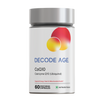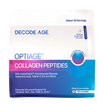Often, breathing is confused with respiration. Respiration or cellular respiration is what converts our foods into energy and helps in the sustenance of life. Cellular respiration is a complex process and one of the many key players is NAD+. But how does NAD+ concern us with longevity science and why are we talking biochemistry here? well, because NAD+ is one of the components that determine the way we age. Continue reading ahead to find out the biochemistry of living.
Overview of NAD+
Nicotinamide adenine dinucleotide (NAD+) is a vital coenzyme that plays a fundamental role in cellular respiration. A coenzyme or a cofactor is a non-protein compound without which the main enzymes will not function. NAD+ is several in redox reactions, meaning it aids in the transfer of electrons from one molecule to another. Think of it as an electron carrier molecule or a shuttle bus. NAD+ is naturally derived from the B-vitamin niacin and is present in all living cells. It exists in two forms: NAD+ (oxidized) and NADH (reduced), which interconvert based on the redox reactions they participate in.
Without NAD+, many biochemical reactions will cease to exist and ultimately, it will lead to cellular death.
Stages of Cellular Respiration
Cellular respiration is a biochemical process by which cells generate energy in the form of adenosine triphosphate (ATP) from glucose and other organic molecules. It occurs in three main stages:
Glycolysis

Glycolysis is the step of cellular respiration that takes place in the cytoplasm, wherein glucose, the six-carbon sugar undergoes a series of chemical transformations. The end product of glycolysis is two molecules of pyruvate and NADH (where NAD+ is converted to NADH)
The Krebs cycle (also known as the citric acid cycle or TCA cycle)

The citric acid cycle takes place in the mitochondria of the cell. Pyruvate, produced in glycolysis, is further broken down in a series of chemical reactions. Each pyruvate molecule is converted into acetyl CoA, which then enters the citric acid cycle. In this cycle, acetyl CoA combines with oxaloacetate to form citric acid, which undergoes a series of reactions, ultimately producing ATP, NADH, and FADH2 (flavin adenine dinucleotide). These high-energy electron carriers (NADH and FADH2) will be utilized in the final stage of cellular respiration.
Oxidative phosphorylation (electron transport chain).

The final stage of cellular respiration occurs in the inner membrane of the mitochondria. It involves a series of electron transport chain (ETC) reactions and ATP synthesis. The NADH and FADH2 produced in the previous stages deliver high-energy electrons to the ETC. As the electrons move through the ETC, energy is released and used to pump protons (H+) across the inner mitochondrial membrane, creating an electrochemical gradient. This gradient drives ATP synthesis through the enzyme ATP synthase, resulting in the production of a large amount of ATP., the energy currency of our cell. At the end of the ETC, oxygen serves as the final electron acceptor, combining with protons to form water.
Role of NAD+ in Cellular Respiration
The role of NAD+ is crucial as a coenzyme in several steps of cellular respiration. It serves as an electron carrier, shuttling electrons from one reaction to another. During cellular respiration, NAD+ accepts electrons and becomes reduced to NADH. This reduction reaction is essential in extracting energy from glucose and other organic molecules.
NAD+ Involvement in the Krebs Cycle
In the Krebs cycle, NAD+ is involved in multiple reactions. It functions as an electron carrier in the conversion of isocitrate to alpha-ketoglutarate and alpha-ketoglutarate to succinyl-CoA. In these reactions, NAD+ accepts high-energy electrons from the intermediates of the cycle, becoming reduced to NADH.
The electrons carried by NADH are later used in the electron transport chain to generate ATP through oxidative phosphorylation. NADH donates its electrons to the electron transport chain, allowing for the production of a proton gradient across the inner mitochondrial membrane. This gradient is then utilized to synthesize ATP.
Importance of NAD+ Regeneration
As NADH accumulates in cellular respiration, it must be converted back to NAD+ to sustain the ongoing redox reactions. Without a mechanism to regenerate NAD+, the reactions that require NAD+ as a coenzyme would cease.
One crucial pathway involved in NAD+ regeneration is the process of fermentation, where NADH transfers its electrons to an organic molecule, regenerating NAD+ and allowing glycolysis to continue.
Additionally, NAD+ can be regenerated through the electron transport chain itself. As electrons pass through the chain, NAD+ is regenerated from NADH. This ensures a continuous supply of NAD+ for the Krebs cycle and other metabolic reactions that require it.
The activity of NAD+ is not only limited to cellular respiration. The longevity molecule, sirtuin too requires NAD+. As we age, the damage that occurs in our body increases, and sirtuins help in repairing that damage. Thus, the maths is simple here, the more the damage, the more sirtuins are required and for sirtuins to function, more NAD+ is required.
This explains why with increasing age, one feels less energetic because for energy production you require the three stages of cellular respiration to take place smoothly and since NAD+ molecules are largely taken up by sirtuins and many other longevity genes for their function. That is where NMN supplementation comes into the picture. NMN is a precursor of NAD+ wherein cells turn into NAD+. In recent times there is enough evidence translating the role of NMN in aiding NAD+ depletion and leading to increased energy levels and several health benefits.
Conclusion
In summary, NAD+ is a crucial coenzyme in cellular respiration. It acts as an electron carrier, shuttling high-energy electrons from one reaction to another. Specifically, NAD+ plays a vital role in the Krebs cycle, facilitating the conversion of isocitrate to alpha-ketoglutarate and alpha-ketoglutarate to succinyl-CoA. Furthermore, NAD+ regeneration is essential to sustain the ongoing redox reactions, which are achieved through fermentation and the electron transport chain. Understanding the role of NAD+ in cellular respiration helps us comprehend the intricacies of energy production in living cells and its significance in various physiological processes, and allows us to make sound choices when it comes to supplementation, such as NMN supplementation for better energy and reversing the signs of ageing.
FAQs
1. What is NAD+ and why is it important in cellular respiration?
NAD+ (nicotinamide adenine dinucleotide) is a coenzyme that plays a crucial role in cellular respiration and other metabolic functions. It is derived from vitamin B3, also known as niacin. NAD+ is involved in redox reactions within cells, acting as an electron carrier. It accepts electrons from one molecule and transfers them to another during cellular respiration, making it an important component in energy production.
2. How does NAD+ participate in the process of glycolysis?
In glycolysis, the initial stage of cellular respiration, glucose is broken down into pyruvate. NAD+ is a key player in this process. It accepts electrons from the intermediate molecules produced during glycolysis. This transfer of electrons oxidizes NAD+ to NADH, which carries the electrons to the next stage of cellular respiration.
3. What is the role of NAD+ in the Krebs cycle (Citric Acid Cycle)?
The Krebs cycle, also known as the Citric Acid Cycle or the TCA cycle (tricarboxylic acid cycle), is the second stage of cellular respiration. NAD+ is vital in this cycle as it accepts high-energy electrons released from the breakdown of acetyl-CoA, a molecule derived from pyruvate. The transfer of electrons from acetyl-CoA to NAD+ forms NADH. These NADH molecules carry the electrons to the electron transport chain, the final stage of cellular respiration.
4. Why is NAD+ regeneration crucial in cellular respiration?
During cellular respiration, NAD+ is reduced to NADH as it accepts electrons. However, for cellular respiration to continue, NAD+ needs to be regenerated so that it can participate in glycolysis and the Krebs cycle again. The regeneration of NAD+ is crucial because it enables the continuous production of ATP (adenosine triphosphate), the energy currency of the cell. ATP provides the energy needed for various cellular processes, including muscle contraction, cell division, and active transport.




















Leave a comment
All comments are moderated before being published.
This site is protected by hCaptcha and the hCaptcha Privacy Policy and Terms of Service apply.